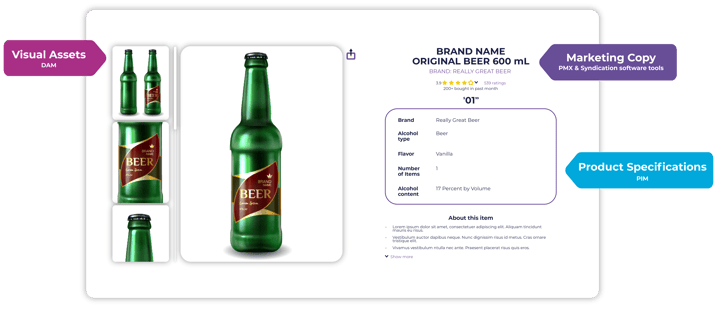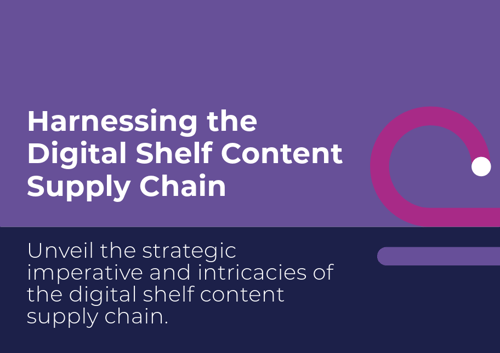DIGITAL SHELF
Aligning, activating and accelerating content for the digital shelf
THE ROLE OF DIGITAL SHELF
We know that digital influence has a significant impact on both online and offline sales globally, in fact, according to a report by McKinsey, an estimated 80% of sales are digitally influenced. Are you optimizing your digital shelf for omnichannel sales?

icp's digital shelf solutions
A top-performing digital shelf strategy is not simply about having a presence on digital platforms. It involves a coordinated effort across multiple teams, a variety of content types, efficient workflows, well-defined processes and the right technology systems.
With ICP's content operations expertise, our digital shelf solutions simplify the complexity of orchestrating the multiple product content types required across various teams and technology systems.
%E2%80%8B-%E2%80%8B%20%E2%80%8B.png?length=256&name=__Align%20(Content%20Alignment)%E2%80%8B-%E2%80%8B%20%E2%80%8B.png)
SOLUTION: INITIATE
Connect the dots across your content landscape. We help you align internal teams, platforms, and workflows across PIM, DAM, and commerce systems—ensuring your digital shelf strategy is built on solid foundations and ready to scale.
%E2%80%8B%20%E2%80%8B.png?length=256&name=__Implement-%20(Technology%20Implementation)%E2%80%8B%20%E2%80%8B.png)
SOLUTION: IMPLEMENT
Design and implement the right mix of people, process, and platform to manage digital shelf content at scale. We work with you to deploy proven frameworks and tailored workflows that reflect how your business—and your retail partners—actually operate.
%E2%80%8B.png?length=256&name=__Adopt-%20(Technology%20Adoption)%E2%80%8B.png)
SOLUTION: ADOPT
Drive confidence and consistency across teams managing your digital shelf. We identify adoption blockers, upskill teams, and embed governance that improves quality, reduces rework, and ensures every product experience meets your brand standards.

SOLUTION: OPERATE
Keep digital shelf operations running smoothly—at scale and speed. We manage workflows, channels, and resources to ensure content is accurate, optimised, and live when it matters most, with the flexibility to adapt to changing priorities.
.png?length=256&name=__Activate%20(Content%20Activation).png)
SOLUTION: SYNDICATE
Accelerate speed to shelf. We help you define, automate, and scale the workflows that get your content to channel partners efficiently and accurately—maximising visibility, minimising delays, and improving consistency across markets.
.png?length=256&name=Data_%20Outcome_White%20BG%20(1).png)
SOLUTION: ANALYSE
Understand how your content performs on the digital shelf. We help you track key metrics, identify gaps, and interpret insights—connecting operational data to business outcomes so you can continuously improve delivery, quality, and engagement.

Harnessing the Digital Shelf Content Supply Chain
Unveil the intricacies of the digital shelf content supply chain and learn how mastering it can set your brand apart in the digital marketplace.
ExploreAccelerated activation, trusted partners
Reaching your customers across every channel takes more than great content—it takes powerful platforms and the right integration strategy. That’s why we work with the best in PIM, syndication, and digital shelf analytics to connect content, commerce, and performance.
From onboarding to optimisation, we bring deep alignment with our partners to give you seamless support, clearer visibility, and a digital shelf ecosystem that’s built for scale.
Helping global companies achieve a frictionless flow of content.













































.png?length=800&name=Untitled-4-CrOps%20Maturity%20Assessment%20landing%20page%20graphic%20(1).png)


%E2%80%8B-%E2%80%8B%20%E2%80%8B.png?length=256&name=Purple%20B__Align%20(Content%20Alignment)%E2%80%8B-%E2%80%8B%20%E2%80%8B.png)
%E2%80%8B-%E2%80%8B%20%E2%80%8B-1.png?length=256&name=__Align%20(Content%20Alignment)%E2%80%8B-%E2%80%8B%20%E2%80%8B-1.png)
%E2%80%8B%20%E2%80%8B.png?length=256&name=Blue%20B__Implement-%20(Technology%20Implementation)%E2%80%8B%20%E2%80%8B.png)
%E2%80%8B.png?length=256&name=Blue%20B__Adopt-%20(Technology%20Adoption)%E2%80%8B.png)









%E2%80%8B-%E2%80%8B%20%E2%80%8B.png?length=256&name=Blue%20B__Align%20(Content%20Alignment)%E2%80%8B-%E2%80%8B%20%E2%80%8B.png)
%E2%80%8B%20%E2%80%8B.png?length=256&name=Cyan%20B__Implement-%20(Technology%20Implementation)%E2%80%8B%20%E2%80%8B.png)
.png?length=256&name=Blue%20B__Activate%20(Content%20Activation).png)










